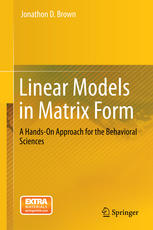

Most ebook files are in PDF format, so you can easily read them using various software such as Foxit Reader or directly on the Google Chrome browser.
Some ebook files are released by publishers in other formats such as .awz, .mobi, .epub, .fb2, etc. You may need to install specific software to read these formats on mobile/PC, such as Calibre.
Please read the tutorial at this link: https://ebookbell.com/faq
We offer FREE conversion to the popular formats you request; however, this may take some time. Therefore, right after payment, please email us, and we will try to provide the service as quickly as possible.
For some exceptional file formats or broken links (if any), please refrain from opening any disputes. Instead, email us first, and we will try to assist within a maximum of 6 hours.
EbookBell Team

5.0
58 reviewsThis textbook is an approachable introduction to statistical analysis using matrix algebra. Prior knowledge of matrix algebra is not necessary. Advanced topics are easy to follow through analyses that were performed on an open-source spreadsheet using a few built-in functions. These topics include ordinary linear regression, as well as maximum likelihood estimation, matrix decompositions, nonparametric smoothers and penalized cubic splines. Each data set (1) contains a limited number of observations to encourage readers to do the calculations themselves, and (2) tells a coherent story based on statistical significance and confidence intervals. In this way, students will learn how the numbers were generated and how they can be used to make cogent arguments about everyday matters. This textbook is designed for use in upper level undergraduate courses or first year graduate courses.
The first chapter introduces students to linear equations, then covers matrix algebra, focusing on three essential operations: sum of squares, the determinant, and the inverse. These operations are explained in everyday language, and their calculations are demonstrated using concrete examples. The remaining chapters build on these operations, progressing from simple linear regression to mediational models with bootstrapped standard errors.